Entrepreneurship and Small Business Management
VerifiedAdded on 2023/06/07
|10
|1842
|434
AI Summary
This report covers different types of entrepreneurial ventures and their relation to typology of entrepreneurship. It also explores similarities and differences between entrepreneurial ventures and how micro and small businesses impact the economy. The report uses Mighty Bear Games as an example to explain key aspects of entrepreneurship. Course code, course name, and college/university are not mentioned.
Contribute Materials
Your contribution can guide someone’s learning journey. Share your
documents today.

Entrepreneurship and
small business
management
small business
management
Secure Best Marks with AI Grader
Need help grading? Try our AI Grader for instant feedback on your assignments.
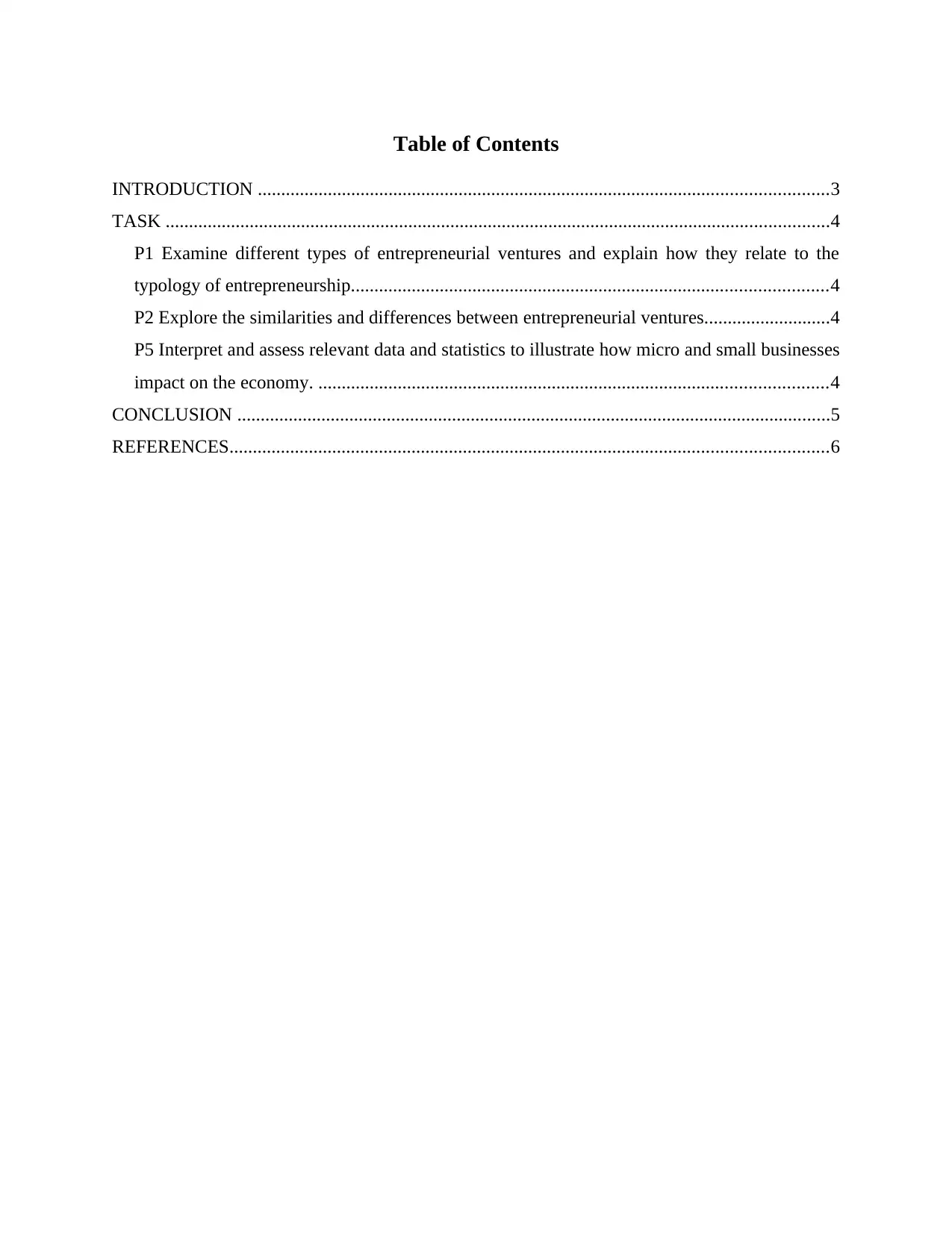
Table of Contents
INTRODUCTION ..........................................................................................................................3
TASK ..............................................................................................................................................4
P1 Examine different types of entrepreneurial ventures and explain how they relate to the
typology of entrepreneurship......................................................................................................4
P2 Explore the similarities and differences between entrepreneurial ventures...........................4
P5 Interpret and assess relevant data and statistics to illustrate how micro and small businesses
impact on the economy. .............................................................................................................4
CONCLUSION ...............................................................................................................................5
REFERENCES................................................................................................................................6
INTRODUCTION ..........................................................................................................................3
TASK ..............................................................................................................................................4
P1 Examine different types of entrepreneurial ventures and explain how they relate to the
typology of entrepreneurship......................................................................................................4
P2 Explore the similarities and differences between entrepreneurial ventures...........................4
P5 Interpret and assess relevant data and statistics to illustrate how micro and small businesses
impact on the economy. .............................................................................................................4
CONCLUSION ...............................................................................................................................5
REFERENCES................................................................................................................................6
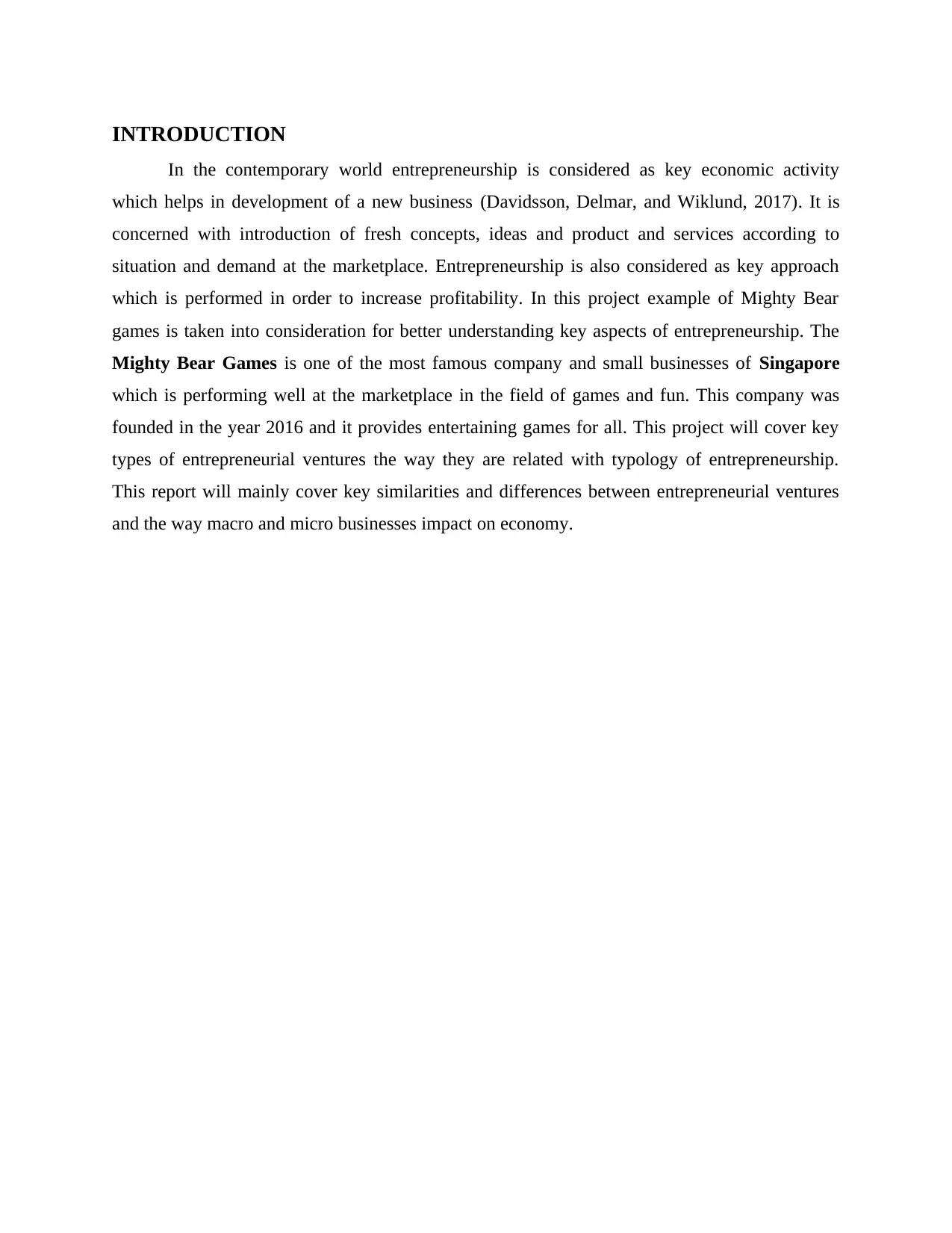
INTRODUCTION
In the contemporary world entrepreneurship is considered as key economic activity
which helps in development of a new business (Davidsson, Delmar, and Wiklund, 2017). It is
concerned with introduction of fresh concepts, ideas and product and services according to
situation and demand at the marketplace. Entrepreneurship is also considered as key approach
which is performed in order to increase profitability. In this project example of Mighty Bear
games is taken into consideration for better understanding key aspects of entrepreneurship. The
Mighty Bear Games is one of the most famous company and small businesses of Singapore
which is performing well at the marketplace in the field of games and fun. This company was
founded in the year 2016 and it provides entertaining games for all. This project will cover key
types of entrepreneurial ventures the way they are related with typology of entrepreneurship.
This report will mainly cover key similarities and differences between entrepreneurial ventures
and the way macro and micro businesses impact on economy.
In the contemporary world entrepreneurship is considered as key economic activity
which helps in development of a new business (Davidsson, Delmar, and Wiklund, 2017). It is
concerned with introduction of fresh concepts, ideas and product and services according to
situation and demand at the marketplace. Entrepreneurship is also considered as key approach
which is performed in order to increase profitability. In this project example of Mighty Bear
games is taken into consideration for better understanding key aspects of entrepreneurship. The
Mighty Bear Games is one of the most famous company and small businesses of Singapore
which is performing well at the marketplace in the field of games and fun. This company was
founded in the year 2016 and it provides entertaining games for all. This project will cover key
types of entrepreneurial ventures the way they are related with typology of entrepreneurship.
This report will mainly cover key similarities and differences between entrepreneurial ventures
and the way macro and micro businesses impact on economy.
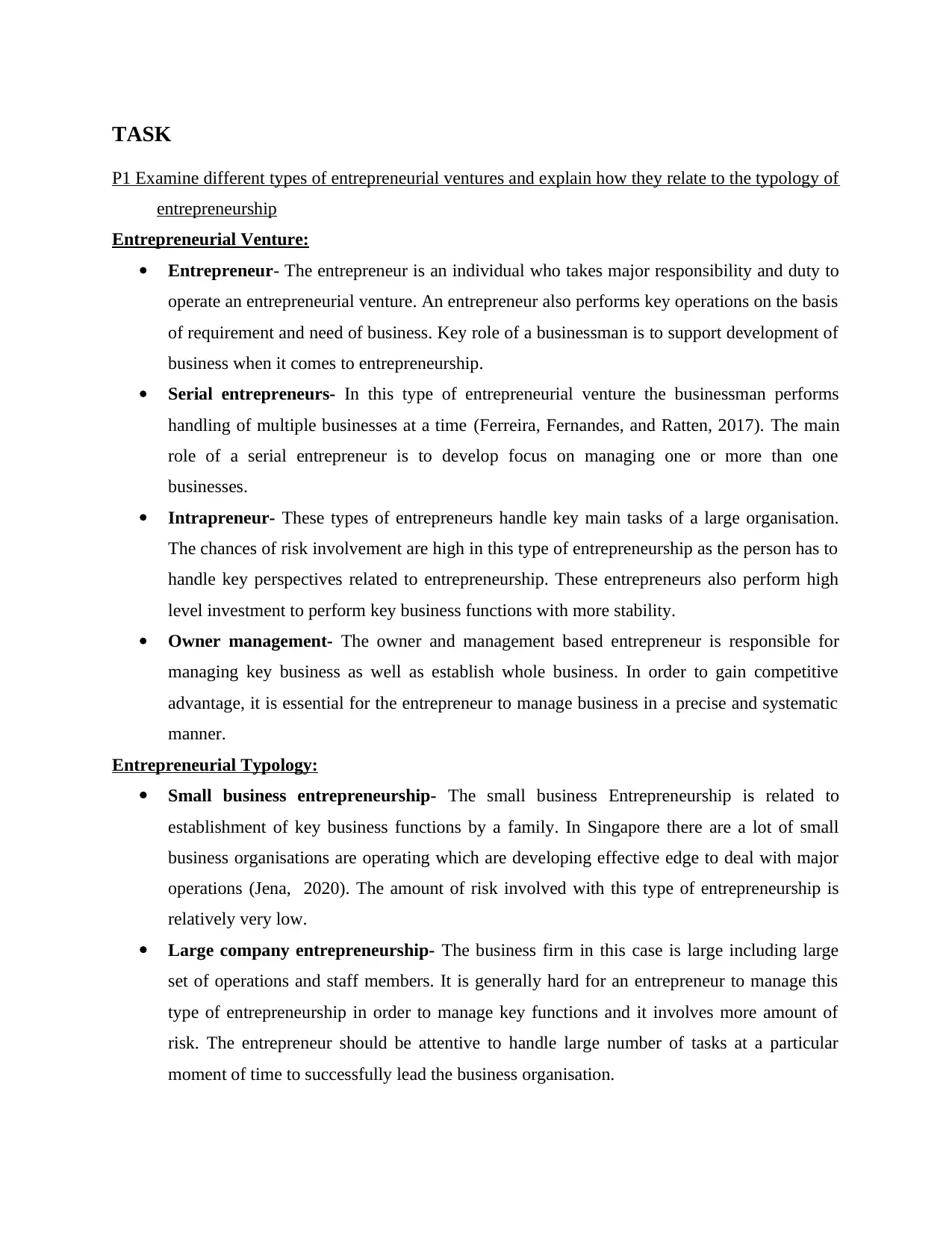
TASK
P1 Examine different types of entrepreneurial ventures and explain how they relate to the typology of
entrepreneurship
Entrepreneurial Venture:
Entrepreneur- The entrepreneur is an individual who takes major responsibility and duty to
operate an entrepreneurial venture. An entrepreneur also performs key operations on the basis
of requirement and need of business. Key role of a businessman is to support development of
business when it comes to entrepreneurship.
Serial entrepreneurs- In this type of entrepreneurial venture the businessman performs
handling of multiple businesses at a time (Ferreira, Fernandes, and Ratten, 2017). The main
role of a serial entrepreneur is to develop focus on managing one or more than one
businesses.
Intrapreneur- These types of entrepreneurs handle key main tasks of a large organisation.
The chances of risk involvement are high in this type of entrepreneurship as the person has to
handle key perspectives related to entrepreneurship. These entrepreneurs also perform high
level investment to perform key business functions with more stability.
Owner management- The owner and management based entrepreneur is responsible for
managing key business as well as establish whole business. In order to gain competitive
advantage, it is essential for the entrepreneur to manage business in a precise and systematic
manner.
Entrepreneurial Typology:
Small business entrepreneurship- The small business Entrepreneurship is related to
establishment of key business functions by a family. In Singapore there are a lot of small
business organisations are operating which are developing effective edge to deal with major
operations (Jena, 2020). The amount of risk involved with this type of entrepreneurship is
relatively very low.
Large company entrepreneurship- The business firm in this case is large including large
set of operations and staff members. It is generally hard for an entrepreneur to manage this
type of entrepreneurship in order to manage key functions and it involves more amount of
risk. The entrepreneur should be attentive to handle large number of tasks at a particular
moment of time to successfully lead the business organisation.
P1 Examine different types of entrepreneurial ventures and explain how they relate to the typology of
entrepreneurship
Entrepreneurial Venture:
Entrepreneur- The entrepreneur is an individual who takes major responsibility and duty to
operate an entrepreneurial venture. An entrepreneur also performs key operations on the basis
of requirement and need of business. Key role of a businessman is to support development of
business when it comes to entrepreneurship.
Serial entrepreneurs- In this type of entrepreneurial venture the businessman performs
handling of multiple businesses at a time (Ferreira, Fernandes, and Ratten, 2017). The main
role of a serial entrepreneur is to develop focus on managing one or more than one
businesses.
Intrapreneur- These types of entrepreneurs handle key main tasks of a large organisation.
The chances of risk involvement are high in this type of entrepreneurship as the person has to
handle key perspectives related to entrepreneurship. These entrepreneurs also perform high
level investment to perform key business functions with more stability.
Owner management- The owner and management based entrepreneur is responsible for
managing key business as well as establish whole business. In order to gain competitive
advantage, it is essential for the entrepreneur to manage business in a precise and systematic
manner.
Entrepreneurial Typology:
Small business entrepreneurship- The small business Entrepreneurship is related to
establishment of key business functions by a family. In Singapore there are a lot of small
business organisations are operating which are developing effective edge to deal with major
operations (Jena, 2020). The amount of risk involved with this type of entrepreneurship is
relatively very low.
Large company entrepreneurship- The business firm in this case is large including large
set of operations and staff members. It is generally hard for an entrepreneur to manage this
type of entrepreneurship in order to manage key functions and it involves more amount of
risk. The entrepreneur should be attentive to handle large number of tasks at a particular
moment of time to successfully lead the business organisation.
Secure Best Marks with AI Grader
Need help grading? Try our AI Grader for instant feedback on your assignments.
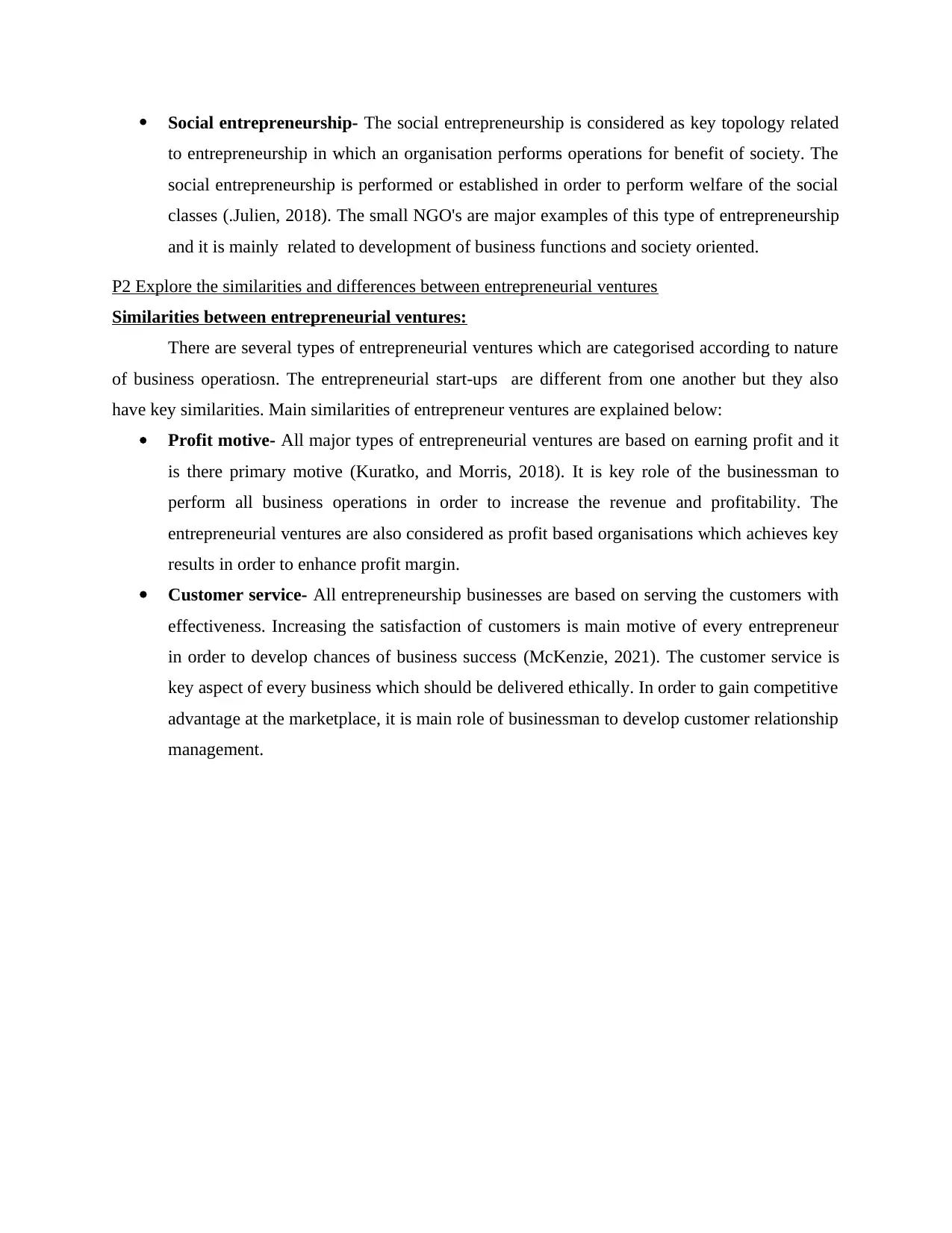
Social entrepreneurship- The social entrepreneurship is considered as key topology related
to entrepreneurship in which an organisation performs operations for benefit of society. The
social entrepreneurship is performed or established in order to perform welfare of the social
classes (.Julien, 2018). The small NGO's are major examples of this type of entrepreneurship
and it is mainly related to development of business functions and society oriented.
P2 Explore the similarities and differences between entrepreneurial ventures
Similarities between entrepreneurial ventures:
There are several types of entrepreneurial ventures which are categorised according to nature
of business operatiosn. The entrepreneurial start-ups are different from one another but they also
have key similarities. Main similarities of entrepreneur ventures are explained below:
Profit motive- All major types of entrepreneurial ventures are based on earning profit and it
is there primary motive (Kuratko, and Morris, 2018). It is key role of the businessman to
perform all business operations in order to increase the revenue and profitability. The
entrepreneurial ventures are also considered as profit based organisations which achieves key
results in order to enhance profit margin.
Customer service- All entrepreneurship businesses are based on serving the customers with
effectiveness. Increasing the satisfaction of customers is main motive of every entrepreneur
in order to develop chances of business success (McKenzie, 2021). The customer service is
key aspect of every business which should be delivered ethically. In order to gain competitive
advantage at the marketplace, it is main role of businessman to develop customer relationship
management.
to entrepreneurship in which an organisation performs operations for benefit of society. The
social entrepreneurship is performed or established in order to perform welfare of the social
classes (.Julien, 2018). The small NGO's are major examples of this type of entrepreneurship
and it is mainly related to development of business functions and society oriented.
P2 Explore the similarities and differences between entrepreneurial ventures
Similarities between entrepreneurial ventures:
There are several types of entrepreneurial ventures which are categorised according to nature
of business operatiosn. The entrepreneurial start-ups are different from one another but they also
have key similarities. Main similarities of entrepreneur ventures are explained below:
Profit motive- All major types of entrepreneurial ventures are based on earning profit and it
is there primary motive (Kuratko, and Morris, 2018). It is key role of the businessman to
perform all business operations in order to increase the revenue and profitability. The
entrepreneurial ventures are also considered as profit based organisations which achieves key
results in order to enhance profit margin.
Customer service- All entrepreneurship businesses are based on serving the customers with
effectiveness. Increasing the satisfaction of customers is main motive of every entrepreneur
in order to develop chances of business success (McKenzie, 2021). The customer service is
key aspect of every business which should be delivered ethically. In order to gain competitive
advantage at the marketplace, it is main role of businessman to develop customer relationship
management.
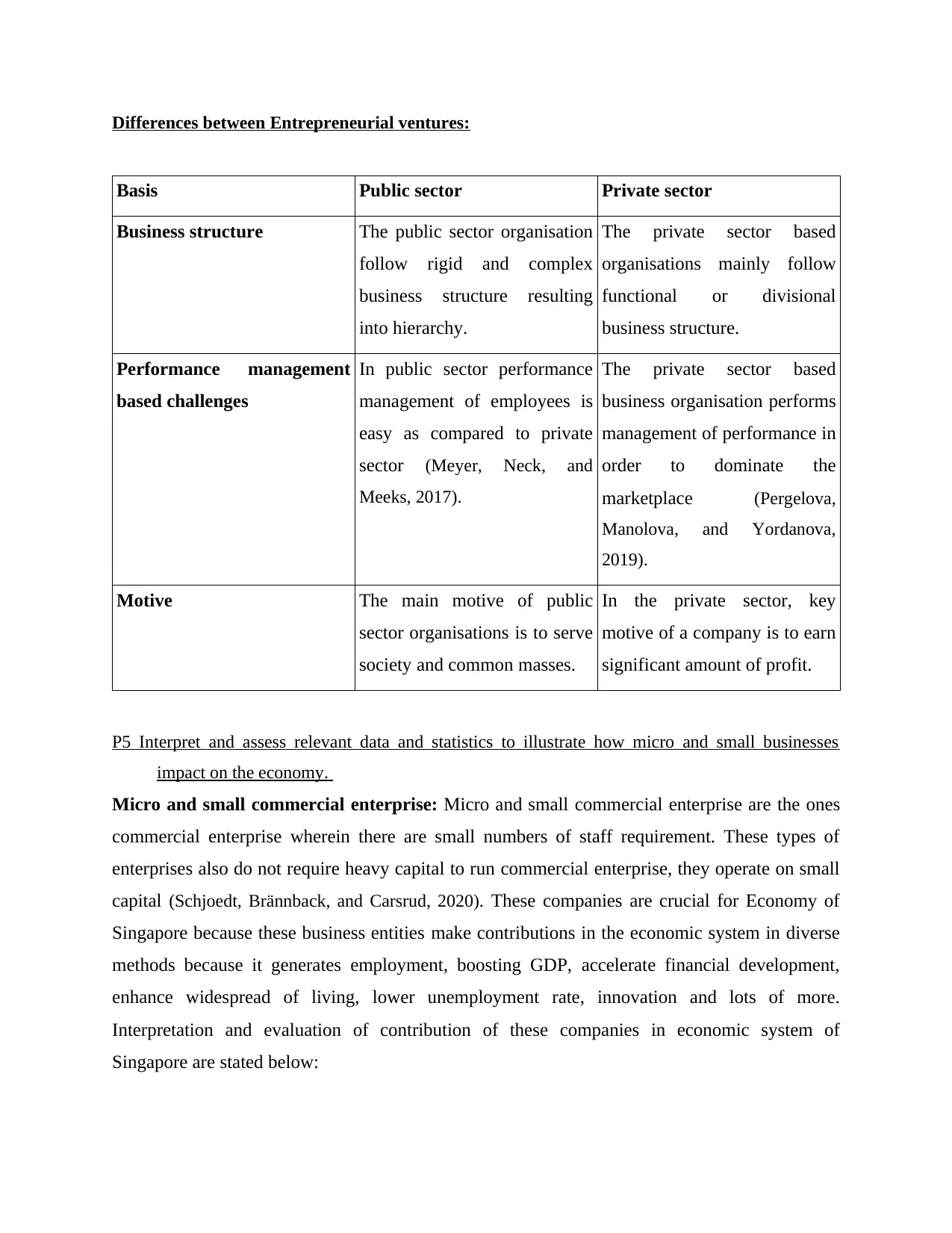
Differences between Entrepreneurial ventures:
Basis Public sector Private sector
Business structure The public sector organisation
follow rigid and complex
business structure resulting
into hierarchy.
The private sector based
organisations mainly follow
functional or divisional
business structure.
Performance management
based challenges
In public sector performance
management of employees is
easy as compared to private
sector (Meyer, Neck, and
Meeks, 2017).
The private sector based
business organisation performs
management of performance in
order to dominate the
marketplace (Pergelova,
Manolova, and Yordanova,
2019).
Motive The main motive of public
sector organisations is to serve
society and common masses.
In the private sector, key
motive of a company is to earn
significant amount of profit.
P5 Interpret and assess relevant data and statistics to illustrate how micro and small businesses
impact on the economy.
Micro and small commercial enterprise: Micro and small commercial enterprise are the ones
commercial enterprise wherein there are small numbers of staff requirement. These types of
enterprises also do not require heavy capital to run commercial enterprise, they operate on small
capital (Schjoedt, Brännback, and Carsrud, 2020). These companies are crucial for Economy of
Singapore because these business entities make contributions in the economic system in diverse
methods because it generates employment, boosting GDP, accelerate financial development,
enhance widespread of living, lower unemployment rate, innovation and lots of more.
Interpretation and evaluation of contribution of these companies in economic system of
Singapore are stated below:
Basis Public sector Private sector
Business structure The public sector organisation
follow rigid and complex
business structure resulting
into hierarchy.
The private sector based
organisations mainly follow
functional or divisional
business structure.
Performance management
based challenges
In public sector performance
management of employees is
easy as compared to private
sector (Meyer, Neck, and
Meeks, 2017).
The private sector based
business organisation performs
management of performance in
order to dominate the
marketplace (Pergelova,
Manolova, and Yordanova,
2019).
Motive The main motive of public
sector organisations is to serve
society and common masses.
In the private sector, key
motive of a company is to earn
significant amount of profit.
P5 Interpret and assess relevant data and statistics to illustrate how micro and small businesses
impact on the economy.
Micro and small commercial enterprise: Micro and small commercial enterprise are the ones
commercial enterprise wherein there are small numbers of staff requirement. These types of
enterprises also do not require heavy capital to run commercial enterprise, they operate on small
capital (Schjoedt, Brännback, and Carsrud, 2020). These companies are crucial for Economy of
Singapore because these business entities make contributions in the economic system in diverse
methods because it generates employment, boosting GDP, accelerate financial development,
enhance widespread of living, lower unemployment rate, innovation and lots of more.
Interpretation and evaluation of contribution of these companies in economic system of
Singapore are stated below:
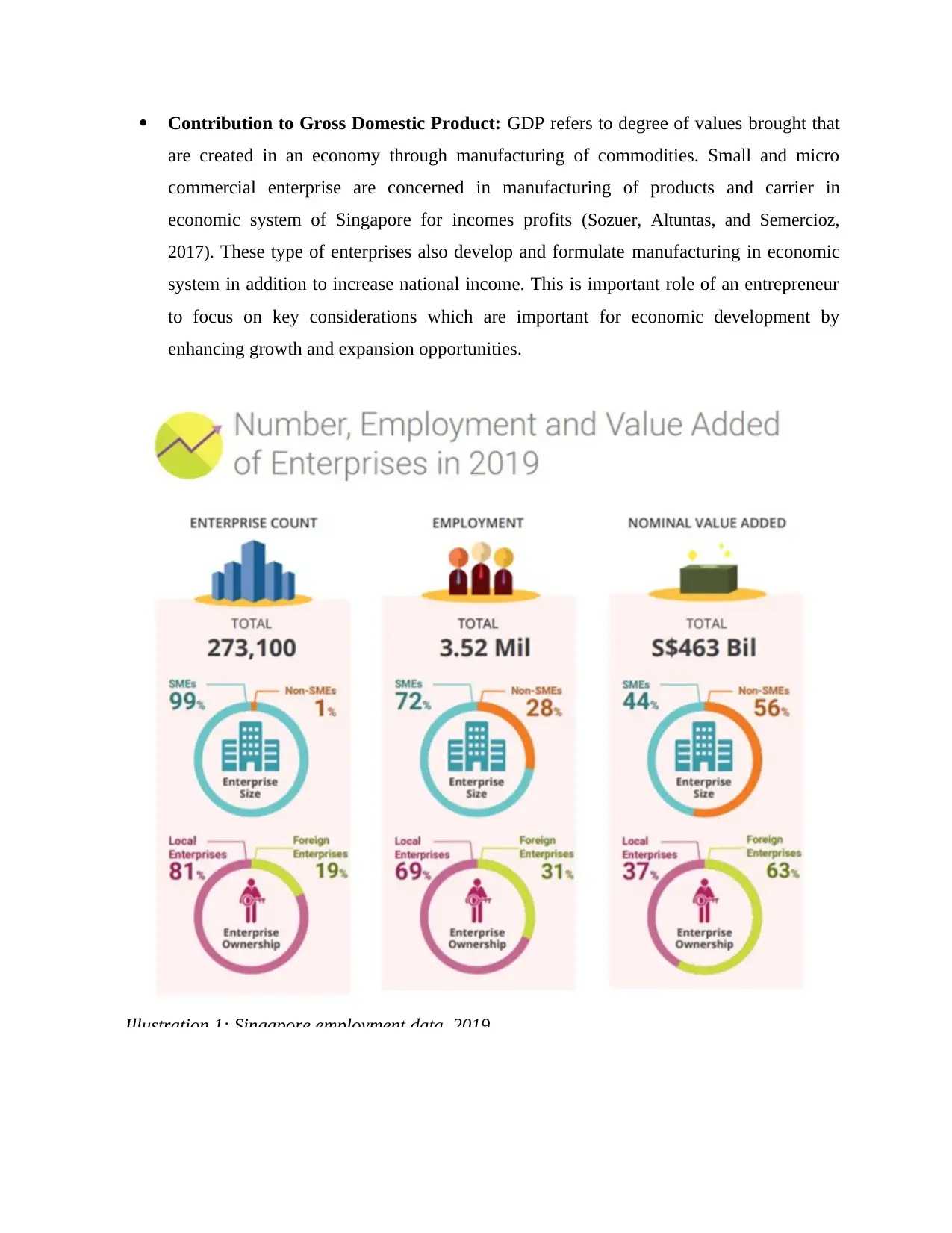
Contribution to Gross Domestic Product: GDP refers to degree of values brought that
are created in an economy through manufacturing of commodities. Small and micro
commercial enterprise are concerned in manufacturing of products and carrier in
economic system of Singapore for incomes profits (Sozuer, Altuntas, and Semercioz,
2017). These type of enterprises also develop and formulate manufacturing in economic
system in addition to increase national income. This is important role of an entrepreneur
to focus on key considerations which are important for economic development by
enhancing growth and expansion opportunities.
Illustration 1: Singapore employment data, 2019
are created in an economy through manufacturing of commodities. Small and micro
commercial enterprise are concerned in manufacturing of products and carrier in
economic system of Singapore for incomes profits (Sozuer, Altuntas, and Semercioz,
2017). These type of enterprises also develop and formulate manufacturing in economic
system in addition to increase national income. This is important role of an entrepreneur
to focus on key considerations which are important for economic development by
enhancing growth and expansion opportunities.
Illustration 1: Singapore employment data, 2019
Paraphrase This Document
Need a fresh take? Get an instant paraphrase of this document with our AI Paraphraser

Contribution in Creation of employment: The small and micro commercial enterprises
are smooth to set up which require less staff member for final touch in their task. In this
way, it will increase employment possibility in economic system of Singapore and allows
to lower unemployment rate (Theodoraki, and Messeghem, 2017). In Singapore, there are
several number of micro and small commercial enterprise which care growing
employment possibilities in the economic system.
Illustration 2: Data of Singapore country related to GDP, 2022,
are smooth to set up which require less staff member for final touch in their task. In this
way, it will increase employment possibility in economic system of Singapore and allows
to lower unemployment rate (Theodoraki, and Messeghem, 2017). In Singapore, there are
several number of micro and small commercial enterprise which care growing
employment possibilities in the economic system.
Illustration 2: Data of Singapore country related to GDP, 2022,
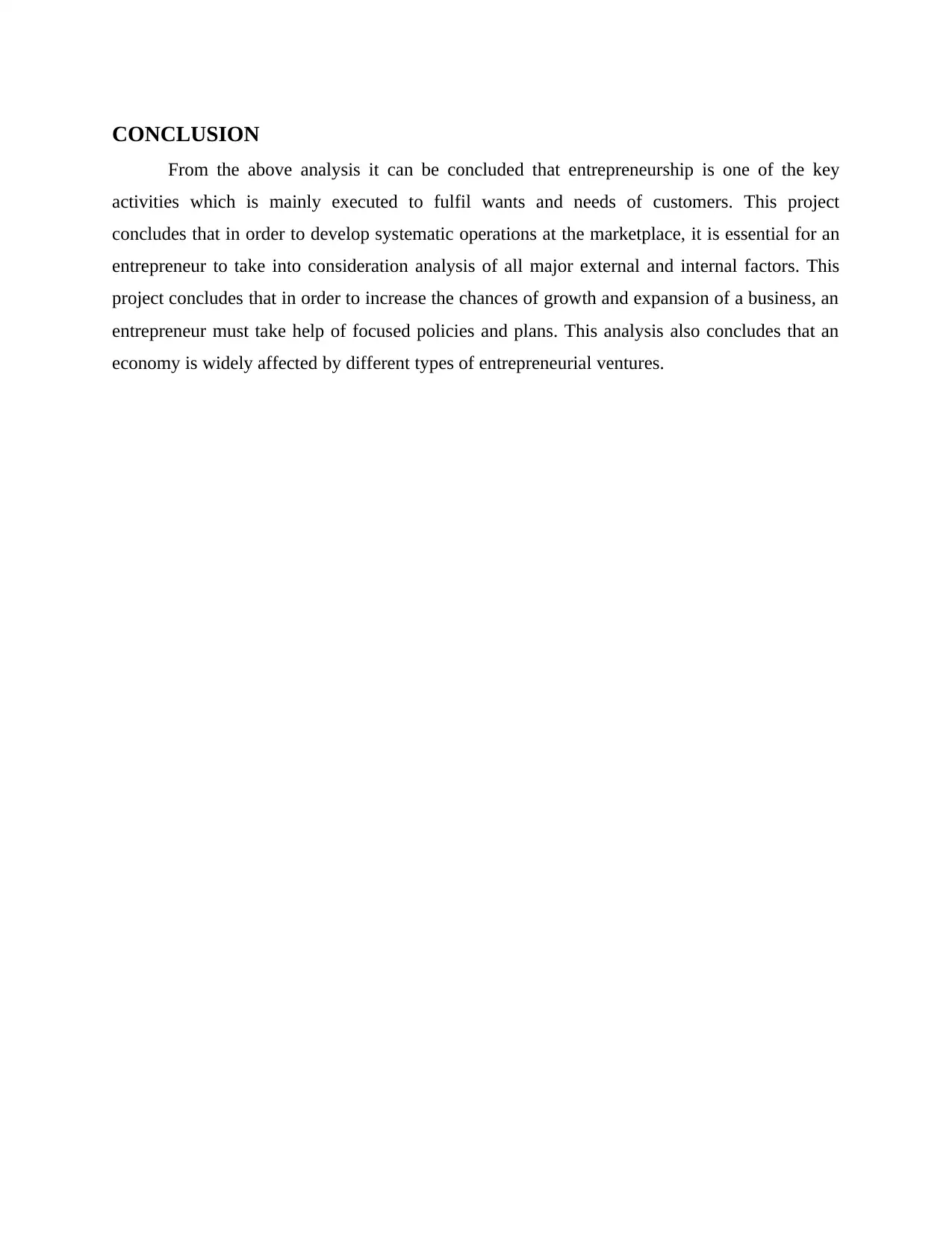
CONCLUSION
From the above analysis it can be concluded that entrepreneurship is one of the key
activities which is mainly executed to fulfil wants and needs of customers. This project
concludes that in order to develop systematic operations at the marketplace, it is essential for an
entrepreneur to take into consideration analysis of all major external and internal factors. This
project concludes that in order to increase the chances of growth and expansion of a business, an
entrepreneur must take help of focused policies and plans. This analysis also concludes that an
economy is widely affected by different types of entrepreneurial ventures.
From the above analysis it can be concluded that entrepreneurship is one of the key
activities which is mainly executed to fulfil wants and needs of customers. This project
concludes that in order to develop systematic operations at the marketplace, it is essential for an
entrepreneur to take into consideration analysis of all major external and internal factors. This
project concludes that in order to increase the chances of growth and expansion of a business, an
entrepreneur must take help of focused policies and plans. This analysis also concludes that an
economy is widely affected by different types of entrepreneurial ventures.
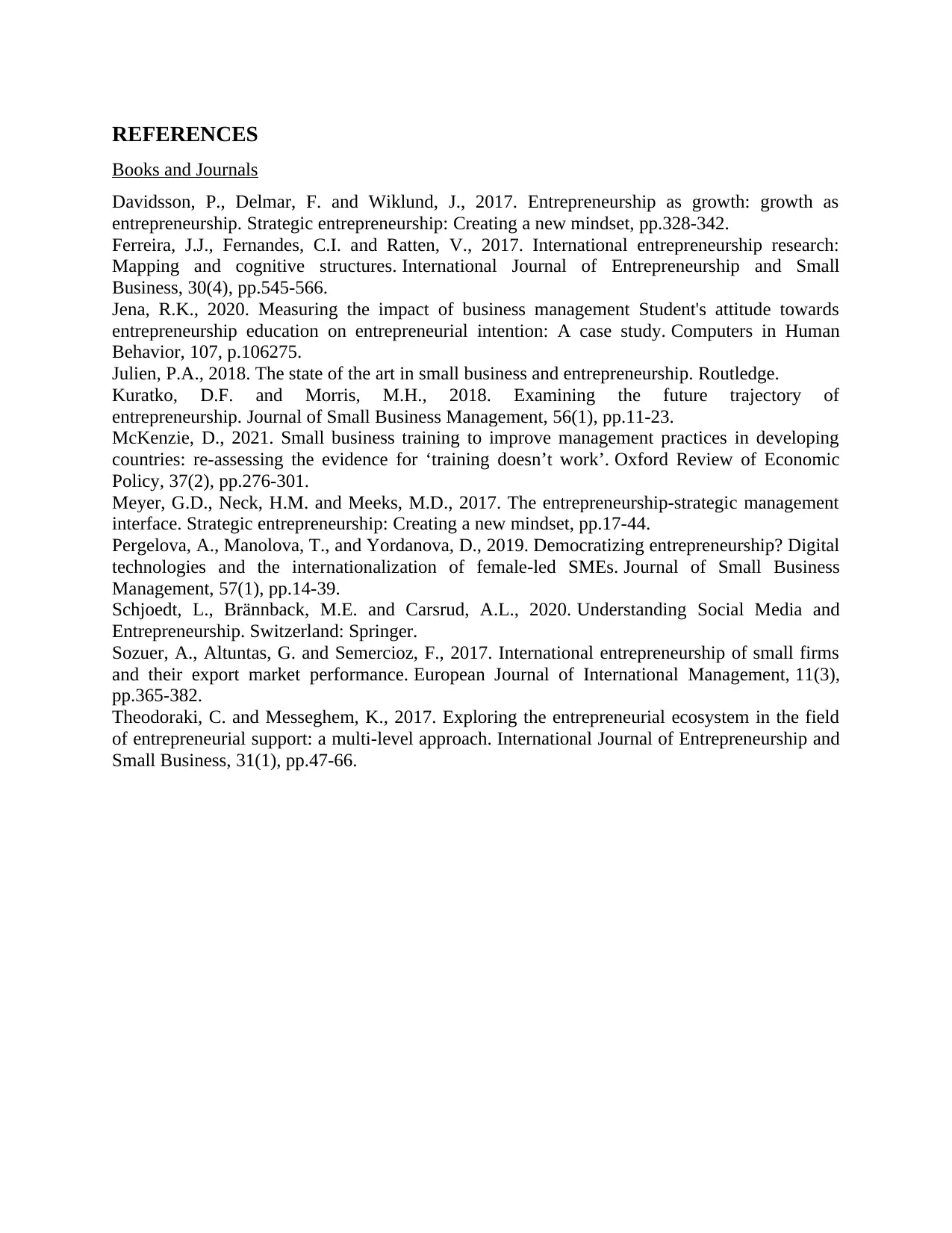
REFERENCES
Books and Journals
Davidsson, P., Delmar, F. and Wiklund, J., 2017. Entrepreneurship as growth: growth as
entrepreneurship. Strategic entrepreneurship: Creating a new mindset, pp.328-342.
Ferreira, J.J., Fernandes, C.I. and Ratten, V., 2017. International entrepreneurship research:
Mapping and cognitive structures. International Journal of Entrepreneurship and Small
Business, 30(4), pp.545-566.
Jena, R.K., 2020. Measuring the impact of business management Student's attitude towards
entrepreneurship education on entrepreneurial intention: A case study. Computers in Human
Behavior, 107, p.106275.
Julien, P.A., 2018. The state of the art in small business and entrepreneurship. Routledge.
Kuratko, D.F. and Morris, M.H., 2018. Examining the future trajectory of
entrepreneurship. Journal of Small Business Management, 56(1), pp.11-23.
McKenzie, D., 2021. Small business training to improve management practices in developing
countries: re-assessing the evidence for ‘training doesn’t work’. Oxford Review of Economic
Policy, 37(2), pp.276-301.
Meyer, G.D., Neck, H.M. and Meeks, M.D., 2017. The entrepreneurship‐strategic management
interface. Strategic entrepreneurship: Creating a new mindset, pp.17-44.
Pergelova, A., Manolova, T., and Yordanova, D., 2019. Democratizing entrepreneurship? Digital
technologies and the internationalization of female‐led SMEs. Journal of Small Business
Management, 57(1), pp.14-39.
Schjoedt, L., Brännback, M.E. and Carsrud, A.L., 2020. Understanding Social Media and
Entrepreneurship. Switzerland: Springer.
Sozuer, A., Altuntas, G. and Semercioz, F., 2017. International entrepreneurship of small firms
and their export market performance. European Journal of International Management, 11(3),
pp.365-382.
Theodoraki, C. and Messeghem, K., 2017. Exploring the entrepreneurial ecosystem in the field
of entrepreneurial support: a multi-level approach. International Journal of Entrepreneurship and
Small Business, 31(1), pp.47-66.
Books and Journals
Davidsson, P., Delmar, F. and Wiklund, J., 2017. Entrepreneurship as growth: growth as
entrepreneurship. Strategic entrepreneurship: Creating a new mindset, pp.328-342.
Ferreira, J.J., Fernandes, C.I. and Ratten, V., 2017. International entrepreneurship research:
Mapping and cognitive structures. International Journal of Entrepreneurship and Small
Business, 30(4), pp.545-566.
Jena, R.K., 2020. Measuring the impact of business management Student's attitude towards
entrepreneurship education on entrepreneurial intention: A case study. Computers in Human
Behavior, 107, p.106275.
Julien, P.A., 2018. The state of the art in small business and entrepreneurship. Routledge.
Kuratko, D.F. and Morris, M.H., 2018. Examining the future trajectory of
entrepreneurship. Journal of Small Business Management, 56(1), pp.11-23.
McKenzie, D., 2021. Small business training to improve management practices in developing
countries: re-assessing the evidence for ‘training doesn’t work’. Oxford Review of Economic
Policy, 37(2), pp.276-301.
Meyer, G.D., Neck, H.M. and Meeks, M.D., 2017. The entrepreneurship‐strategic management
interface. Strategic entrepreneurship: Creating a new mindset, pp.17-44.
Pergelova, A., Manolova, T., and Yordanova, D., 2019. Democratizing entrepreneurship? Digital
technologies and the internationalization of female‐led SMEs. Journal of Small Business
Management, 57(1), pp.14-39.
Schjoedt, L., Brännback, M.E. and Carsrud, A.L., 2020. Understanding Social Media and
Entrepreneurship. Switzerland: Springer.
Sozuer, A., Altuntas, G. and Semercioz, F., 2017. International entrepreneurship of small firms
and their export market performance. European Journal of International Management, 11(3),
pp.365-382.
Theodoraki, C. and Messeghem, K., 2017. Exploring the entrepreneurial ecosystem in the field
of entrepreneurial support: a multi-level approach. International Journal of Entrepreneurship and
Small Business, 31(1), pp.47-66.
1 out of 10
Related Documents
Your All-in-One AI-Powered Toolkit for Academic Success.
+13062052269
info@desklib.com
Available 24*7 on WhatsApp / Email
![[object Object]](/_next/static/media/star-bottom.7253800d.svg)
Unlock your academic potential
© 2024 | Zucol Services PVT LTD | All rights reserved.




